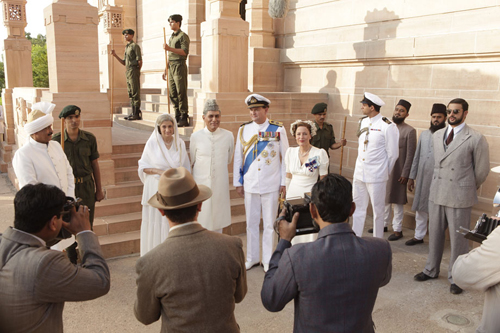
DAVID ADAMS watches the period drama Viceroy’s House, set amid the tumultuous partition of India and Pakistan…
Viceroy’s House (PG)
In a word: Instructive

Hugh Bonneville and Gillian Anderson star as Lord and Lady Mountbatten in Viceroy’s House.
“Yes, the history takes over in this story but if you have an interest in how the modern states of India and Pakistan came to be, that’s not a problem. If you’re after a love story, however, this probably won’t satisfy.”
In 1947, India gained its independence – bringing to an end 300 years of British rule – and, thanks to the drawing of new borders through parts of India, the new nation of Pakistan was created. While the creation of the two new nations were a cause for celebration for many, during violence which preceded and continued after what is known as the Partition of India, more than a million people were killed and some 14 million displaced from their homes.
Viceroy’s House tells some of the background to that event, following the story of the last British Viceroy of India, Lord Louis “Dickie” Mountbatten (here played by Hugh Bonneville of Downton Abbey fame), who arrived in India with his family – his wife Edwina (Gillian Anderson) and daughter Pamela (Lily Travers – the real Lady Pamela was a consultant on the film) with the express purpose of transitioning India to independence with as little violence as possible.
From the get-go his role was a big ask with conflict between Muslims and Hindus already breaking out across the country as Pakistan’s future leader Jinnah (Denzil Smith) agitated for the creation of a separate state, Indian leader Nehru (Tanveer Ghani) sought to protect the interests of Indians and Gandhi (Neeraj Kabi) supported one united country.
It was not to be – as the film tells it, faced with escalating violence, Mountbatten brought forward the proposed timetable for independence and decided, in what he saw a bid to minimise unrest, to back the idea of Partition, which became known as the ‘Mountbatten Plan’ and which, as it turned out – according to the film at least, was actually more to do with Britain protecting its own strategic interests in the area.
Centred on the Viceroy’s House in Delhi (which became Government House in an independent India), the story is tackled at two levels – through the story of the Viceroy and his family but also through the stories of some of the 500 Indians in service at the house, particularly star-crossed lovers, Hindu Jeet Kumar (Manish Dayal), who works as a valet, and Muslim girl Aalia Noor (Huma Qureshi), who is among those charged with looking after Lady Pamela.
It’s an ambitious project for director Gurinder Chadha (whose own family was uprooted from their home in what is now Pakistan during the Partition) and such is its scale that we’re kept at a bit of a distance from all the characters involved. This gives it something of the feel of a docu-drama – a sense enhanced by the real footage shown during the end credits – which is not a bad thing in itself, but ultimately leaves the film somewhat emotionally isolated from the audience.
Bonneville (in full Lord Grantham mode) and Anderson both put in strong performances as do the two young co-stars, Dayal and Qureshi (although their story is largely overshadowed) and additional players like Simon Callow, who plays Cyril Radcliffe – the hapless man charged with creating the new borders) and Michael Gambon, who plays the viceroy’s wily chief-of-staff General Hastings ‘Pug’ Ismay.
And while the narrative is certainly central to this film’s success (although the way in which the film handles its telling of the events has received some criticism), the great strength of the film is in its evocative recreation of life in the Viceroy’s House during this most tumultuous of times.
Yes, the history takes over in this story but if you have an interest in how the modern states of India and Pakistan came to be, that’s not a problem. If you’re after a love story, however, this probably won’t satisfy.





